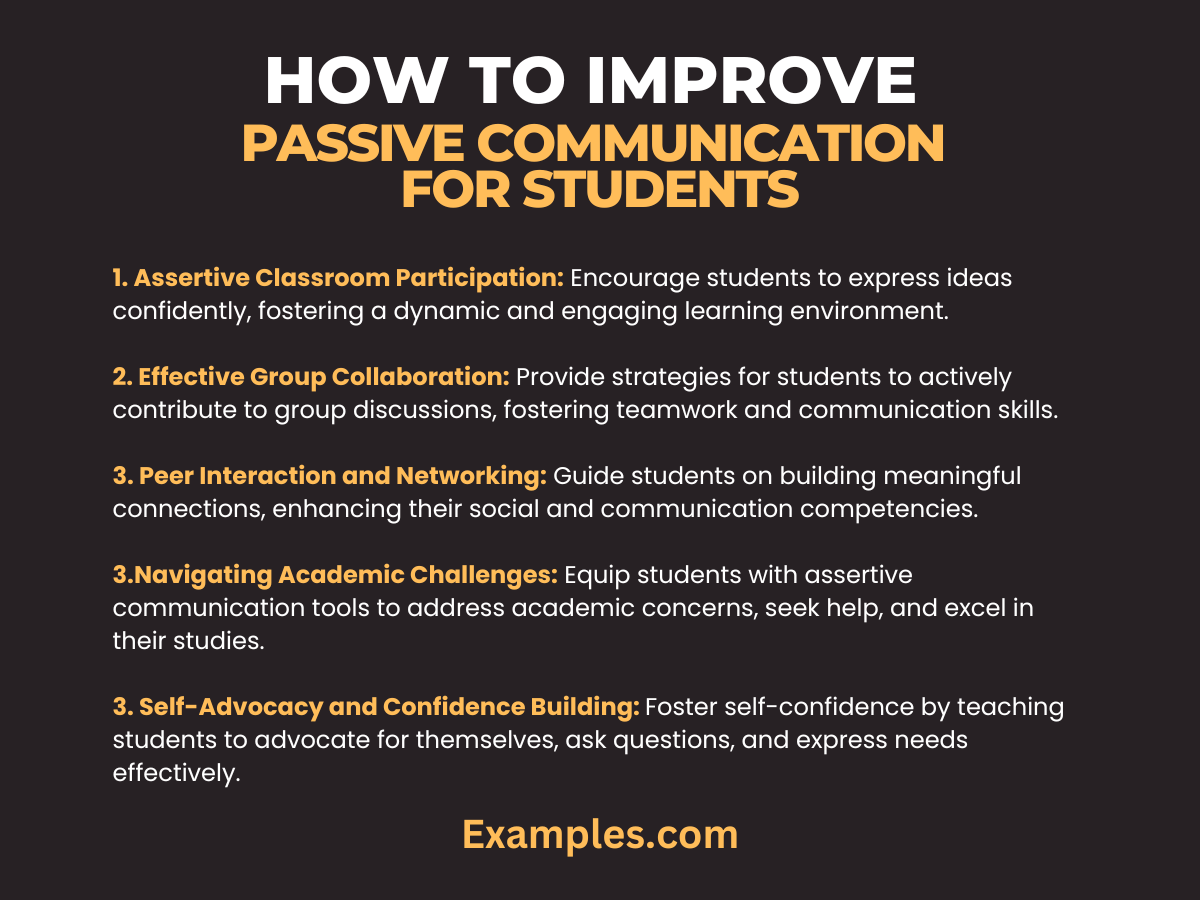How to Improve Passive Communication?
Embark on a transformative journey to enhance your communication prowess by exploring How to Improve Passive Communication. This guide offers invaluable insights, practical examples, and actionable tips to help you break free from passivity. Navigate through real-life Communication Examples that illuminate the path to assertiveness, fostering more impactful and meaningful interactions in both personal and professional spheres. Elevate your communication skills and embrace a more confident and effective expression.
How to Improve Passive Communication for Students
Passive communication can hinder a student’s academic and personal growth. In this comprehensive guide, we explore effective strategies tailored to the student context. From fostering assertiveness in the classroom to enhancing interpersonal skills, discover practical tips, real-life scenarios, and actionable advice. Empower students to break free from passivity, enabling them to express themselves confidently, engage actively in discussions, and navigate the academic landscape with enhanced communication skills.

- Developing Assertiveness Skills:
Empower students to express opinions, ask questions, and actively participate in class discussions. Assertiveness training enhances confidence, promoting more effective communication. - Encouraging Active Participation:
Foster an environment that encourages students to actively engage in discussions, share their perspectives, and contribute to group activities. - Providing Constructive Feedback:
Teach students to give and receive feedback constructively, promoting a culture of open communication and continuous improvement. - Utilizing Technology for Communication:
Explore modern communication tools and platforms that facilitate collaboration, discussion, and engagement among students, breaking down barriers to effective communication. - Building Confidence in Public Speaking:
Implement activities that boost students’ public speaking skills, helping them overcome anxiety and communicate confidently in various academic and social settings. - Cultivating Empathy and Interpersonal Skills:
Emphasize the importance of understanding others’ perspectives, fostering empathy, and building positive relationships through effective communication. - Real-Life Scenarios and Role-Playing Exercises:
Engage students in real-life scenarios and role-playing exercises that mimic communication challenges they may face. This hands-on approach enhances practical communication skills. - Encouraging Peer Collaboration:
Promote collaborative learning environments where students work together, share ideas, and communicate effectively, fostering a sense of community. - Continuous Self-Reflection:
Guide students in reflecting on their communication styles, identifying areas for improvement, and setting personal goals for enhanced communication.
How to Improve Passive Communication in the Workplace
Passive communication in the workplace often manifests as hesitancy to express opinions, reluctance to take on leadership roles, or avoidance of conflicts. Recognizing these patterns is the first step in fostering improvement.

- Understanding Workplace Dynamics: Uncover the nuances of workplace communication, recognizing the impact of tendencies on collaboration and productivity.
- Building Assertive Vocabulary:
Explore the power of words, replacing passive language with assertive expressions to convey ideas confidently. - Navigating Conflict Assertively:
Equip yourself with conflict resolution skills, addressing disagreements openly to maintain a positive work environment. - Active Listening Techniques:
Enhance listening skills to understand colleagues better and respond thoughtfully, promoting effective communication. - Establishing Clear Boundaries:
Set and communicate boundaries to safeguard personal space and maintain a healthy work-life balance. - Expressing Professional Opinions:
Develop confidence in expressing opinions, contributing meaningfully to discussions without fear of judgment. - Incorporating Positive Self-Affirmations:
Boost self-esteem with positive affirmations, reinforcing a confident and assertive professional demeanour. - Leveraging Nonverbal Assertiveness:
Master nonverbal cues to complement assertiveness, using body language to convey confidence and authority. - Proactive Problem-Solving:
Address challenges directly, focusing on collaborative solutions for continuous improvement and growth. - Delivering Constructive Feedback:
Learn to provide feedback constructively, fostering a culture of growth and development within the workplace. - Embracing Difficult Conversations:
Confront challenging discussions with courage, promoting resolution and understanding for a harmonious work environment.
Tips to Improve Passive Communication
Embarking on a journey to transform passive communication requires a strategic approach. Explore these invaluable tips designed to empower individuals in fostering assertiveness, enhancing interpersonal dynamics, and promoting effective expression.
- Embrace Assertiveness Training: Unleash the power of assertiveness workshops and training programs to build confidence, refine communication skills, and overcome passive tendencies.
- Develop Active Listening Skills: Cultivate the art of active listening to truly understand others, respond thoughtfully, and create a more engaging and reciprocal communication environment.
- Cultivate a Positive Self-Image: Boost self-esteem and assertiveness through positive self-affirmations, fostering a mindset that encourages confident expression.
- Practice Nonverbal Assertiveness: Master the nuances of nonverbal communication, utilizing body language and gestures to reinforce assertiveness and convey confidence.
- Set Clear and Healthy Boundaries: Establishing and communicating clear personal boundaries is crucial in avoiding passive behaviour and ensuring respect for individual preferences.
- Use Direct and Clear Language: Cut through ambiguity by employing direct and clear language, minimizing misunderstandings and promoting more effective communication.
- Take Initiative in Problem-Solving: Adopt a proactive approach to problem-solving, addressing challenges head-on and collaborating on solutions to prevent passive avoidance.
- Express Personal Opinions Confidently: Develop the confidence to share personal opinions openly, contributing to discussions and fostering a more assertive communication style.
- Seek Constructive Feedback: Welcome constructive feedback as a tool for growth, using insights to refine communication skills and address areas for improvement.
- Embrace Uncomfortable Conversations: Confronting difficult discussions with courage promotes resolution, understanding, and paves the way for more assertive and impactful communication.
In conclusion, this comprehensive guide unveils the transformative journey of improving passive communication. By embracing assertiveness, active listening, and clear expression, individuals can break free from passivity’s constraints. With practical examples and insightful tips, this guide empowers readers to foster healthier relationships, enhance self-confidence, and communicate more effectively.



